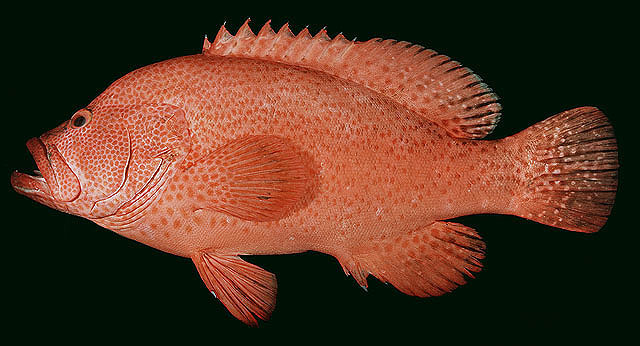
|
Cephalopholis sonnerati (Valenciennes, 1828) Tomato hind |
||
| Lapu-lapu, Tomato hind, Abo-abo, Alatan, Bantol, Baraka, Bato-bato, Batol, Iner, Inid, Jahong, Kakab, Kaltang, Kigting, Kugtong, Kugtung, Kulapo, Kurapo, Labungan, Lapu, Lapu-lapu, Lapu-lapung lupot, Lilug, Lubo, Mamonbong, Maskad, Matkad, Ogaw, Pugapo, Pugayo, Salingukod, Sibog, Sigapo, Subla, Tabadlo, Tangk-an, Ting-ad, Tomato rockcod, Uhami | ||

|
|
photo by
Randall, J.E. |
| Family: | Epinephelidae (Groupers) | |||
| Max. size: | 57 cm TL (male/unsexed) | |||
| Environment: | reef-associated; marine; depth range 10 - 150 m, non-migratory | |||
| Distribution: | Indo-Pacific: east coast of Africa (Djibouti, Socotra to Durban) to the Line Islands, north to southern Japan, south to southern Queensland (Australia). Not found at the Chagos Archipelago despite intensive survey and not reported from the Red Sea and Persian Gulf. | |||
| Diagnosis: | Dorsal spines (total): 9-9; Dorsal soft rays (total): 14-16; Anal spines: 3-3; Anal soft rays: 9-9. This species is distinguished by the following characters: body depth greater than or subequal to head length, 2.3-2.7 times in standard length (for specimens 9-41 cm SL); dorsal head profile of adults straight to concave, the nape distinctly convex; pectoral fins subequal to pelvic fins, 1.5-1.7 times in head length for specimens of 15-40 cm length (in specimens larger than 40 cm, the pelvic fins are longer than the pectoral fins); pelvic fins reaching to or beyond anus; ctenoid body scales, cycloid on abdomen. Colour: Adults from Pacific Ocean generally pale reddish to yellowish brown, covered with numerous small brownish red or dark brown spots on head, body, and fins; while the juveniles are dark reddish brown to nearly black, the rear margin of caudal fin and sometimes pectoral fins whitish; or body brownish orange with scattered pale greenish spots, and black spot between upper and middle opercular spines (Ref. 39231, 90102). Description: Opercular spines very small. Color of adults in Indian Ocean with body orange-red to reddish brown, often with scattered small whitish or purple spots; head purplish to reddish brown with numerous close-set orange-red spots; membrane between lower 2 opercular spines usually darker than rest of head; fins usually darker than body, esp. the caudal and posterior part of dorsal and anal fins; pelvic fins often blackish distally. Caudal fin rounded (Ref. 4787). | |||
| Biology: | Adults occur in deep lagoon reefs and steep outer reef slopes and in coastal areas with rocky substrates. Juveniles are usually found near sponges or coral heads (Ref. 9710). Adults usually at moderate depths with bommies with large holes, usually occupied by cleaner shrimps (Ref. 48635). They are solitary (Ref. 90102) and are usually caught in depths of 30 to 100 m, but in Madagascar, they occur in depths of 10 to 20 m. They feed on small fishes and crustaceans including shrimps, crabs and stomatopods (Ref. 37816). Females mature at about 28 cm SL and males at about 34 cm SL (Ref. 6448). Are sold in Hong Kong live fish markets (Ref. 27253). They are generally marketed fresh (Ref. 5284) and of commercial importance throughout most of its range. They are primarily caught with hook-and-line, spear, and in traps (Ref. 39231). | |||
| IUCN Red List Status: | Least Concern (LC); Date assessed: 15 November 2017 Ref. (130435) | |||
| Threat to humans: | harmless | |||
| Country info: | Known from Cebu City (Ref. 58652) and Lanuza Bay (Ref. 104756). Museum: Mindanao, Zamboanga, USNM 170780-81, 170784-85. Luzon, Manila Market, USNM 170782-83. Also Ref. 4787, 5222, 53416, 121724. | |||